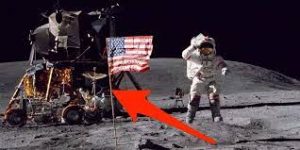Scientists have discovered the unexpected source of the unexplained daily quakes that occur on the moon’s surface.
NASA and California Institute of Technology researchers reanalyzed data on minor moonquakes that astronauts from the Apollo 17 mission had collected in the 1970s. They found that the descent stage of the Apollo 17 lunar module, which was left behind on the lunar surface 51 years ago, was responsible for some of the vibrations.

According to a news statement from coauthor of the new study and research professor of geophysics Allen Husker, “every lunar morning when the sun hits the lander, it starts popping off.”
Even though there is no tectonic action on the moon, it is nevertheless vibrating.
Gathering data regarding the moon’s seismic activity was one of the objectives of the Apollo mission, which took place between 1961 and 1972 and put the first humans on the moon.
During the Apollo missions 11 to 17, astronauts installed seismic detectors on the moon to do this. Seismometers from the Apollo missions ceased to function in 1977, but researchers have continued to reexamine the data to uncover critical details about how our satellite expands and breaks.
These readings were crucial in helping scientists understand moonquakes for the first time. Tremors on the moon do not result from tectonic plate movement like they occur on Earth.
According to a blog article from the European Commission, there are three reasons why a moonquake occurs: a meteor striking the surface, the moon’s innards being stretched or compressed by Earth’s gravity, or the moon’s surface baking in the daytime sun.
The lunar lander is creaking in the hot sun
Despite the fact that the data was collected between October 1976 and May 1977, these earthquakes had never been noticed before.
The Caltech and NASA experts explained this in a research presenting their findings, which was published on September 5 in the peer-reviewed journal JGR Planets. They stated this was due to the readings from the Apollo 17 mission being extremely muddy and challenging to interpret.
These people were able to clean up the data using machine learning. They obtained readings from so-called thermal quakes, which occur in the late afternoon when the moon begins to cool, as they had anticipated.
But every morning, strange waves were also observed by scientists. They identified the cause of the enigmatic tremors by triangulating the signal.
Husker and co-authors Francesco Civilini of Caltech and Renee Weber of the NASA Marshall Space Flight Center conducted the study, which was published in the journal Science. “We found that impulsive moonquakes are not due to natural processes, but are vibrations generated from the lunar module descent vehicle left by the astronauts in 1972,” Husker said.
You can see a portion of the lunar lander that the Apollo 17 astronauts left behind when they departed the moon in the video down below. According to the press release, that chunk of metal, which boils and creaks at temperatures ranging from +250 to -208° F, is what was creating these unexplained earthquakes.

